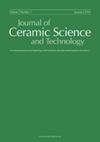烧结后热处理微金颗粒/玻璃陶瓷复合材料的特性
IF 0.4
4区 材料科学
Q4 MATERIALS SCIENCE, CERAMICS
引用次数: 0
摘要
研究了900、1100和1300℃热处理前后金颗粒(GP)增强玻璃陶瓷(GC)复合材料在GP/GC界面的显微组织特征。研究了暴露在断口表面的GP和GC的界面区域以及相关的化学反应。处理后的GC基体具有纳米尺度的双相微观结构,在连续长石基体中均匀分布着孤立的无定形白晶石相。GP/GC复合材料在900℃下加热后,非晶白晶石相转变为白晶石结晶相。在GP/GC界面上发现了Au 2 Si和Au 5 Si 2,证明复合加工过程中确实发生了化学反应。在1100℃和1300℃热处理后,进一步检测了GP和GP/GC界面周围的断口特征,发现在此过程中产生了新的化合物。采用x射线衍射(XRD)和场发射扫描电镜(FESEM)等表征技术,结合能量色散光谱(EDS)进行x射线微分析,研究了GP/GC界面。本文章由计算机程序翻译,如有差异,请以英文原文为准。
Characteristics of micro-gold-particle/glass-ceramic composite from post-sintering thermal treatment
Microstructural characteristics of a gold-particle (GP)-reinforced glass-ceramic (GC) composite at the GP/GC interface were investigated before and after heat treatment at 900, 1100 and 1300 °C. The interfacial regions between the GP and GC exposed on the fracture surface and relevant chemical reactions were examined. The as-processed GC matrix had a nano-scaled biphasic microstructure, with isolated amorphous leucite phase evenly distributed in the continuous feldspar matrix. After the GP/GC composite was heated at 900 °C, the amorphous leucite phases were transformed into leucite crystalline phases. Au 2 Si and Au 5 Si 2 found at the GP/GC interface proved that chemical reactions had indeed occurred during composite processing. Fracture surface features around the GP and GP/GC interface were further examined after heat treatment at 1100 °C and 1300 °C, showing new compounds were produced during the process. Characterization techniques, including X-ray diffraction (XRD) and Field Emission Scanning Electron Microscopy (FESEM), incorporating X-ray microanalysis using Energy-Dispersive Spectrometry (EDS), were employed to study the GP/GC interface.
求助全文
通过发布文献求助,成功后即可免费获取论文全文。
去求助
来源期刊

Journal of Ceramic Science and Technology
MATERIALS SCIENCE, CERAMICS-
CiteScore
0.80
自引率
0.00%
发文量
0
期刊介绍:
The Journal of Ceramic Science and Technology publishes original scientific articles on all topics of ceramic science and technology from all ceramic branches. The focus is on the scientific exploration of the relationships between processing, microstructure and properties of sintered ceramic materials as well as on new processing routes for innovative ceramic materials. The papers may have either theoretical or experimental background. A high quality of publications will be guaranteed by a thorough double blind peer review process.
 求助内容:
求助内容: 应助结果提醒方式:
应助结果提醒方式:


